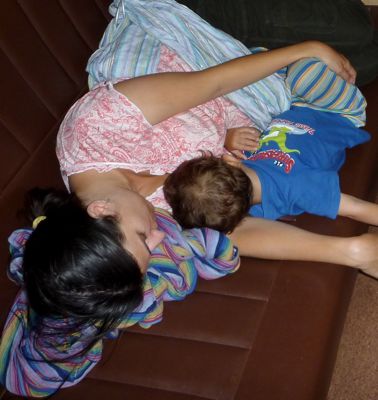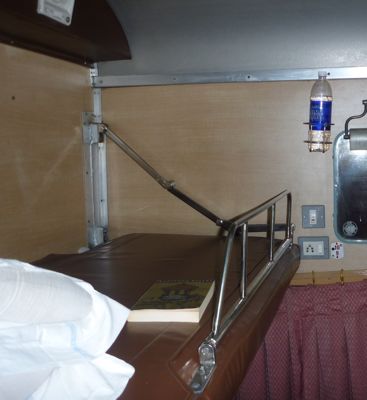Our Vacation in India
Jaipur
On Saturday, May 15th we woke up at 5:00 on the train, knowing that our train would pull into Jaipur around 6:00 but only for a five-minute stop—not the end of the line—so we would need to be ready with our bags in order to get off.
Above: on the train (first class AC!)
We watched the villagers again out the window—the farms, animals, pumps, and people starting their day—and managed to get off the train without a problem. No one from the hotel was there to meet us, though, which was a first so far this trip, so we took an auto rickshaw from an optimistic man (“I have very large tuk-tuk, sir, very large!”). It was actually possible to get in, somehow, with our large duffels crammed onto the seat next to us, and weirdly with the driver’s best friend crammed onto the front seat next to him, but when Marcus (as he tended to do) indicated that he wanted to nurse on the tuk-tuk, I had to put my foot down (actually there wasn’t even room to do that). Everyone was very cozy, at least.
We got to the Jai Mahal Palace nice and early, and although they seemed startled that we arrived via tuk-tuk, the hotel managed to do the standard welcome thing—the dab on the forehead, even a lei. We went to our room, washed up, and went straight to breakfast. This hotel is a heritage property, so an actual 1740s villa/palace, and while it was nice to stay at one old property, it was the least fancy place we stayed our entire trip. Parts of the grounds were a little run-down and shabby, the pool wasn’t fancy or recently renovated, and the rooms had standard hotel-style bedspreads, etc.
Breakfast was another buffet, which we liked because of the diversification; I had uttapam, dosas, idli, and made a crazy juice mixture with cucumber, sweet lime, and watermelon. There was a huge pile of mangoes, and the chef would cut as many as you wanted and bring them to your table freshly sliced (we started small, with just two, but by our last breakfast here we had lost all restraint).
Back in the room, we showered and got ready to go out for the day. We got the hotel car and driver at 9:30 for four hours and went straight to Amber Fort, driving through the Old City along the way. Marcus fell asleep in the car, so I put him in the mei tai and we started our tour of the fort. If he’d been awake, we would’ve had the driver stop and let us take an elephant up to the fort, winding up the hill, but it seemed silly to waste an elephant ride on sleeping baby, so we just drove all the way up.
Below: at Amber Fort
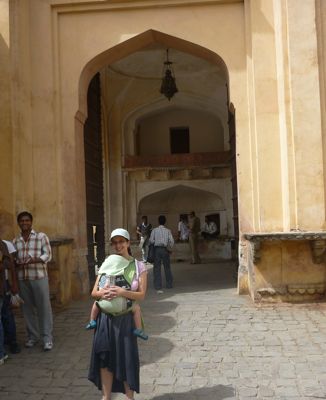
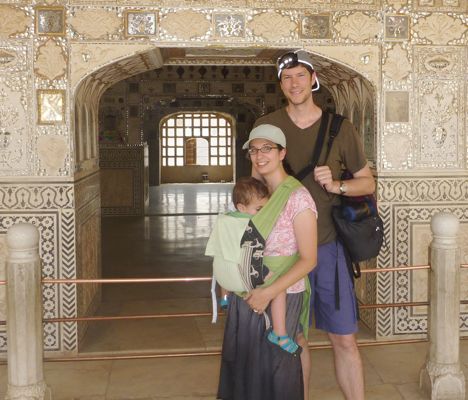
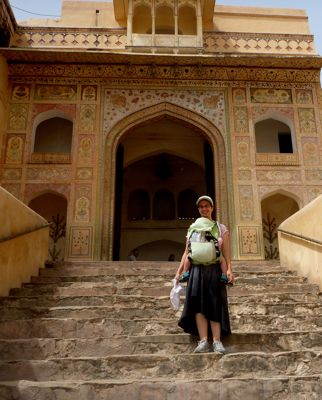
The fort was much better preserved than Udaipur’s City Palace, which was good, because I was starting to wonder if all the official tourist attractions were going to be shabby and crumbling. We didn’t get a guide of our own, but we eavesdropped on a couple of English and Spanish-language guides, and there were actual signs and informative placards in many of the areas, so we managed to learn about the fort as we made our way through. One of the highlights was a secret tunnel with a lot of bats—they didn’t come out perfectly in the picture, though, but it was neat to see them.
Below: looking up at Jagar Fort and back at elephants
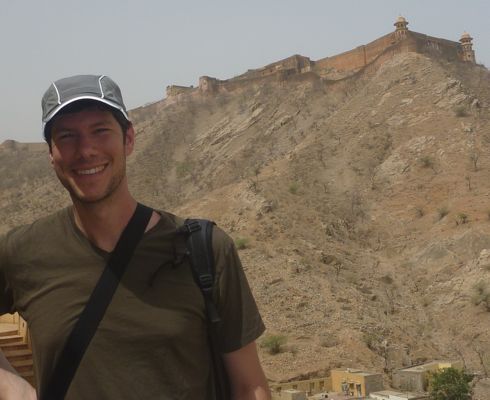
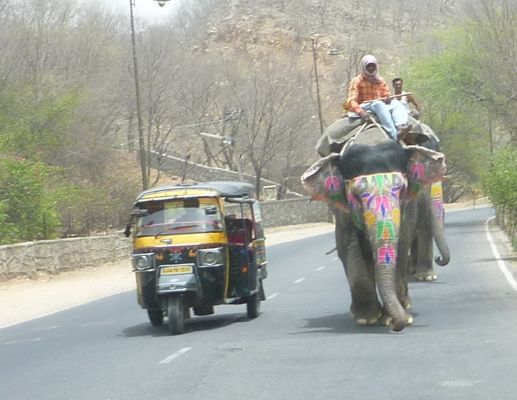
We went back to the car, with Marcus happy and awake, and drove back to the city, stopping at a government-sponsored handicraft shop along the way where we saw demonstrations of wood-block printing with vegetable dyes, weaving, and a few other crafts. Robert fell down a flight of marble stairs in the shop, and was embarrassed but okay. I was sort of shaken, but we bounced back and kept going to the lake, the summer palace, and the old city. We stopped at LMB, a well-known sweet shop, for sweets and gulab jamon, and Marcus had fun playing with the doorman while Robert talked endlessly to the clerk about exactly which milk-based sweet was her favorite. The gulab jamon were excellent, and at 6 rupees each were a fabulous deal. We splurged and paid an extra 5 rupees for a plastic container for them, instead of just keeping them in a plastic bag, and the help in the store clearly though we were insane big spenders. We drove on to the famous Lassiwalla—there’s actually a row of three shops, one the original and most famous one, and two others with virtually indistinguishable names, prices, and awnings. The original, according to our driver, was the green-striped awning, but since they only had plain lassis, Robert got a plain one (plus a bag of curd) from them, and I got a banana lassi from the place next door. We loved that they come in disposable (apparently) clay cups—the street around the lassi stores is absolutely littered with the clay, as people drink their lassis and then toss down the cups, while a man with a cart and a huge bag goes around behind them, picking up salvageable cups and selling them back to the stores. Both lassis were delicious, but I preferred the banana to the plain.
Below: "disposable" (?) cups of lassi and playing in the hotel room
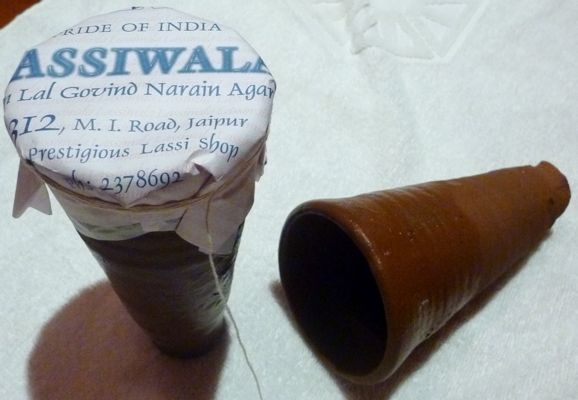
Outside the lassi stands, we saw our first real beggar—a woman with an infant in her arms and a two-year-old holding onto her skirts. Marcus kept saying “Baby! Baby!” at them, and the woman began to nurse the baby, with her scarf pulled over them, while standing there holding out her hand. That was clearly pushing all of my buttons at once—it was really tough to be standing there waiting for Robert to finish his complicated curd transaction and get back to our deluxe air-conditioned car and driver.
Back at the hotel, we snacked on bananas, apples, mangoes, sweets, and lassis, and laid down for a nap at 2:20 in the afternoon. Marcus and I slept a solid twelve hours without moving. Robert did not (clearly an on-going theme)—he said he tried to keep a light on and watch TV or read, but “people” would whimper whenever he did that, so he turned it off. He took a bunch of walks outside, wandering around the hotel, and talked to some boys who were part of a huge, elaborate wedding that had essentially taken over the hotel grounds for the night.
We had actually seen them setting up the wedding, with multiple tents, lots of beds for the guests to recline on, lots of pillows, many fans, and lots and lots of lights, earlier in the day, and our driver told us that this was a particularly auspicious day for weddings in India.
At 3:00, when Marcus and I got up, I was starving—we walked outside along with Robert, who now knew his way around the outskirts of the wedding tents very well, and watched part of it. It was still going strong, with dancing and firecrackers. We walked around by way of the breakfast restaurant, where we grabbed a banana to help tide us over, and then took a bath, played some Legos and ball, watched Indian videos, and went back out at 5:00 as soon as it was light enough to see.
The wedding was winding down now, with just a few guests and the bride and groom still there, and some of the tents beginning to be demolished. Our destination was the hotel’s playground, built apparently in the 70s and now somewhat shabby, with faded paint and a layer of dust on everything. It was clearly a deathtrap playground by modern US safety standards, but it was lots of fun, and it was inhabited at this hour by peacocks and other birds. Marcus was by now a champion bird-spotter. We played until breakfast opened, and wandered over (our favorite breakfast was still the Mumbai Taj buffet, but this was serviceable, especially when the strange tour bus of German tourists cleared out and left us alone there).
After breakfast, with Marcus asleep in a mei tai, we walked to the hotel gate to get an auto rickshaw to the old city. Our plan was to see Jantar Mantar, an old observatory with huge sundials, instruments that predicted the timing of monsoons, etc., and then the City Palace right across the street. This plan was affected by the death of India’s former vice-president, however, who had lived in Jaipur and even had a residence here at the time of his death, so all government-owned sites were closed—no Jantar Mantar, no Amber Fort (good thing we saw it yesterday). We hung around wondering whether to go to City Palace (owned privately by the king, not the government, and therefore open later in the day) once it opened, but we decided we could skip another ill-maintained palace.
Somehow we got talked into a bicycle rickshaw ride around the city—the guy kept saying, “two hours, 30 rupees, I take you, nice nice,” and we figured, well, sure, why not? Why not? Well, after about 15 minutes the constant jostling and exhaust smells combined to make me extremely seasick. Robert was clearly not as comfortable as he’d been on the auto rickshaw, either. All of this, at a super slow pace around the city, but Marcus nevertheless enjoyed being up close and personal with (and super slow behind) the animals who wander around the city—every bird, dog, cow, bull, water buffalo, donkey, sheep, goat, elephant, and camel. At several points, going up a hill, Robert would get out and walk and help push to put less strain on the driver. Robert even insisted he could drive the bike, at one point, but when he tried he found his balance way off with the tricycle-like back seat. Bystanders got a good laugh at the white man riding the rickshaw, though.
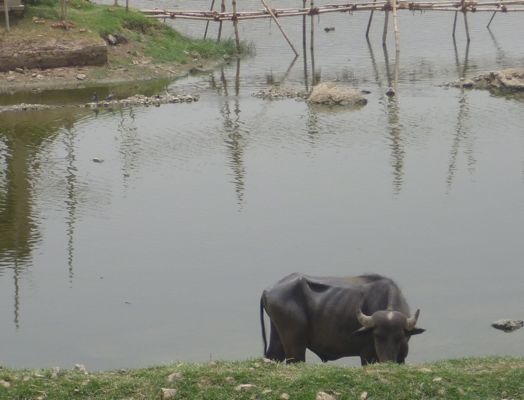
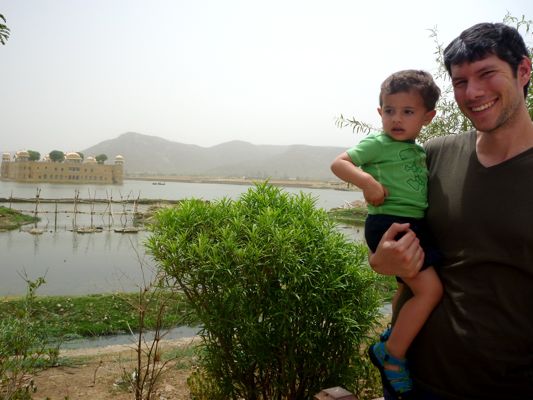
Above: watching water buffalo on the lake.
The driver took us down tiny back alleys to an elephant house, where they were bathing the elephants who go up and down to Amber Fort, and then back to the hotel. We paid him 80 rupees for a one-hour trip, plus 20 rupees to the elephant guy, but then the rickshaw driver demanded more money, which put a sour taste in our mouth. I mean, clearly he had worked incredibly hard, and yes, 80 rupees is about $2, but it rubbed both Robert and me the wrong way that he was deceptive about how much he wanted, so we stuck to our guns.
We did wish we’d brought some US coins, though, as the little kids around the elephant house really wanted them for collections, and we would’ve been happy to give them some. And our driver was nice—his wife was expecting their third child next week, he said, and we talked (as best we could with no Hindi on one side and not a lot of English on the other) about midwives and homebirth. It’s definitely weird thinking about his wife’s birth experience being in some ways more like mine than most of my friends’ experiences here in Boston.
Below: at the elephant house
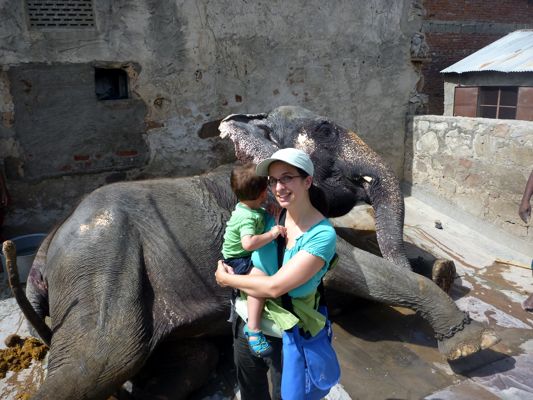
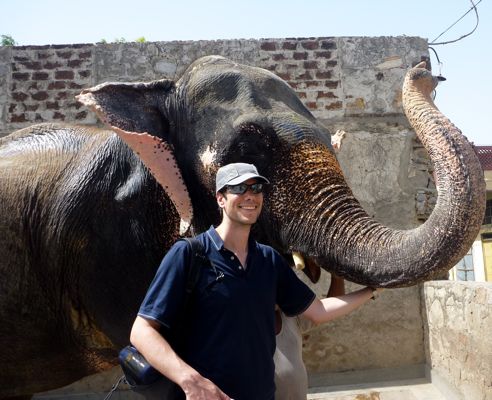
Back at the hotel, we ate mangoes and went swimming in the main pool and played with an old volleyball in the two-foot-deep kiddy pool (another 1970s relic—modern hotels have all renovated their kiddy pools away, Robert says, because of those MBA students) which was perfect for Marcus. After a nap and a shower, we went out at 5:30 to Choki Dhani. I had read in one of my guidebooks that Choki Dhani was a recreation of a traditional Rajasthani village, with performances and elephant rides and dinner included, and it sounded kind of cheesy and touristy and like those awful tourist-geared luaus in Hawaii that we always avoided. But then I figured, well, maybe Marcus would get a kick out of it, so what the heck, Robert and I could deal. I asked at the hotel front desk, sort of hesitantly, saying that we thought we might go there with the baby, and what did they think.
Every employee in the lobby immediately lit up. “Choki Dhani, madam? You will love it!” They gushed. They raced to book our driver and car. They insisted it was the most fun anyone could possibly have in Jaipur and that all three of us would love it.
Now extremely intrigued, but still skeptical, Robert and I figured we might as well, so we got in the car with our (by now familiar) driver, JP, and asked him what he thought of it. He also lit up, and explained that his kids really love it, and beg to go back, and that he likes it too. What the heck, we were sold.
It was indeed a faux village, kind of a Bethpage or Plymouth or something like that, with one entry fee to get you in and then almost everything included: a magician, musicians, dancers, shops, weavers, elephant rides (60 rupees for Robert, Marcus free), camel rides and camel cart rides (10 rupees each for me and Robert, Marcus free), swings, slides so high we avoided them, tall platforms to climb up to for fun, a completely pitch-dark tunnel to walk through apparently just for fun, a rickety ferris wheel we also avoided, a snake charmer, henna hand-painting, and snacks and dinner.
To us, the most amazing thing about this place—where we did, in fact, have a terrific time—was that the vast majority of the people there were all locals, all Indian. There were families—three generations, maybe four, grandparents and cousins and everyone carting around babies and toddlers and then older kids running around—and groups of teenagers, and college students sort of out on big group date/outing things, and then young married couples either with no kids or just an infant in arms, and then groups or 20- and 30-something guys out for a guys’-night-out sort of thing, all post-college friends hanging out and taking pictures of each other riding on elephants. There were two dining rooms—the regular and the deluxe—and in the deluxe room, with weak air conditioning and fancier food, we did end up seeing about 12-15 other westerners, but otherwise everyone there was indeed Indian.
With the deluxe meal, it cost us each 650 rupees to get in (Marcus was free, of course). The food was a Rajasthani thali, served with corn chapatis, the local specialty rather than wheat, and more of those Rajasthani dumplings I’d been trying, as well as a cooked banana pudding type of dish, plus rice and nine other things, as much of whatever as you wanted. Marcus shoveled in more rice, not even stopping for a photograph taken by some friendly New Zealanders who sat next to us. We were all going on to Agra the next day, so we joked that perhaps we would see them there. The place had a great vibe and was a lot of fun, and Marcus loved everything, especially the elephant ride.
Dinner was good, nicely prepared, cooked indoors in a real restaurant-style kitchen, and served with a bottle of water per person, but the “snacks” outside were another story. There was some kind of (tamarind-based?) brown juice, first of all, which I took a sip of and then surreptitiously poured out on the ground, and I think Robert did the same, and then there was a pani puri snack, a bite-sized puri which the man serving it shoved his incredibly grimy thumb into and then scooped a bit of chickpeas in (out of a big vat, with his hand) and finished with the rest of the toppings. He handed me and Robert each one, at one of these outside stands under the broiling sun, and at first there was some confusion on our part about whether this was free (included) or if there was a separate charge. When we finally established that it was free, I smiled and nodded my thanks to him, and said, still facing the man, still smiling, and in a friendly tone of voice, “I’m going to find a trash can and throw this away now,” for Robert’s benefit. I didn’t like the looks of the man or the stand, and free or not, there was no way I was going to eat it. We turned and walked away, and I tossed mine just as Robert popped his in his mouth and then said, “Huh? What? You’re not eating it? Why?” I looked at him, and said, succinctly, “Thumb.” Robert groaned.
(Eight hours later, he was to feel the first stomach rumblings protesting over this thumb-bite (the only thing on the whole trip that Robert ate and I didn’t even try), and a day later he would be genuinely sick.) For now, though, we were happy and enjoyed our time at the Disneyland of Jaipur.
Below: at Choki Dhani, a family destination spot.
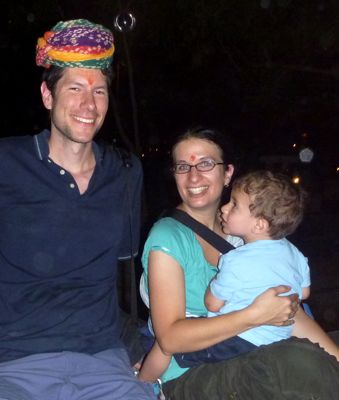
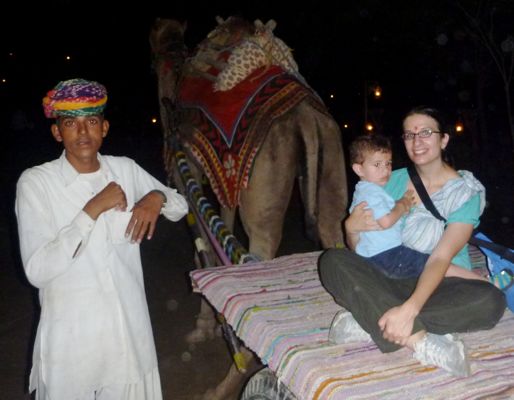
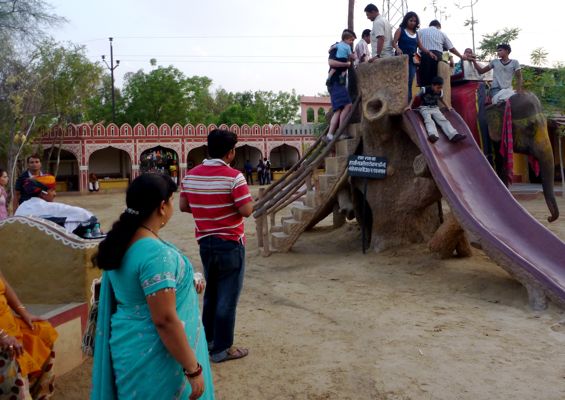
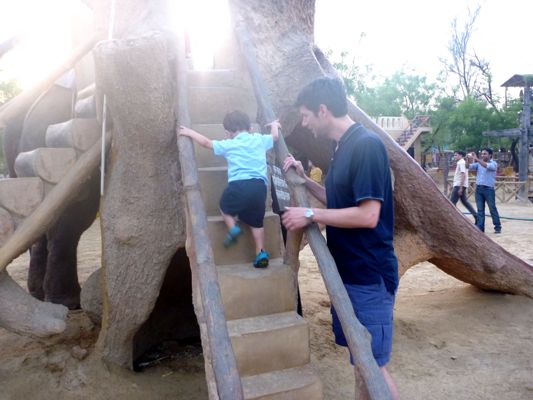
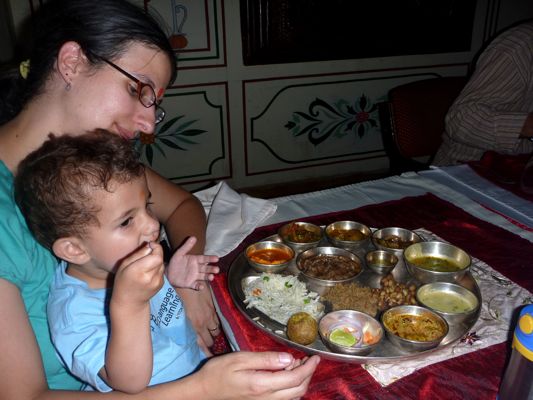
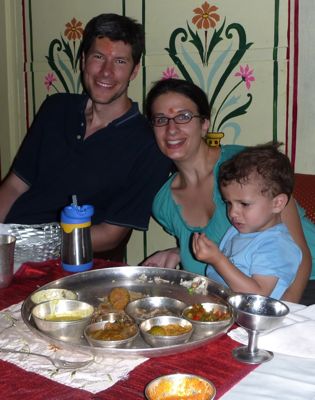
On the way home, with Marcus zonked out on me in the car, JP—who had excellent English—told us lots about Indian culture and life and took detours so we could see even more weddings. We must have passed twenty or so, all of them huge affairs, and JP drove past the wedding garden district and the diplomatic quarter, where the fanciest weddings were in full swing. We also drove past what appeared to be an Indian state fair, but sorry, Sarah, we didn’t go in.
The next morning we woke up at 5:00 and took a nice walk around the hotel grounds before breakfast. We kept meaning to play a game of life-sized chess on the outdoor chessboard with pieces on wheels, but we never quite got around to it, probably because the chessboard was in full sun for most of the day. Even though this hotel wasn’t as deluxe as our previous one, the staff was still incredibly attentive, and very adoring of Marcus—they were forever handing him flowers to give me, and cookies or cups of lemonade for him. They gave him a wrapped-up parting gift of a little plaster Indian Raj figure. Marcus loved it, unwrapping it and kissing it and not letting go of it.
We ate breakfast out on the patio because Marcus was a little restless being cooped up inside, and he walked up and down the stairs near our table feeding the birds bits of dosas. Breakfast was uttapam, Indian masala scrambled eggs, bananas, mango, and mango lassi. Robert was starting to feel the effects of his “thumb” snack, but was trying not to admit it, so he didn’t push things at breakfast, for a change.
At 8:15 we took a car to the train station, which again was big and crowded and disorganized. Since our train didn’t start here, but just pulled in for ten minutes mid-journey, it was again extremely important to find the right platform. We once again barely made it.
